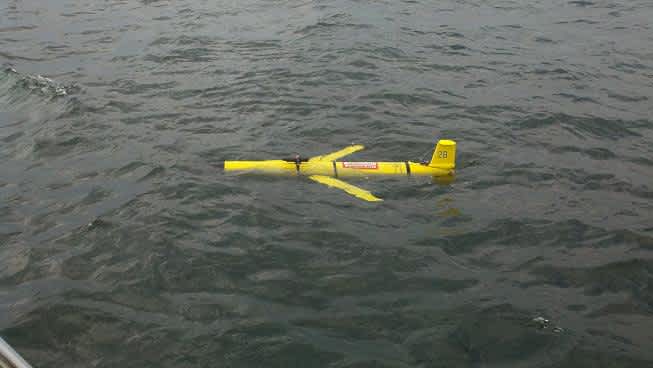New Jersey DEP Launches Research Submersible to Gather Data on Ocean Health
OutdoorHub 07.10.12

The Department of Environmental Protection, Rutgers University and the federal Environmental Protection Agency today launched a research submersible known as the Slocum glider off Sandy Hook that will roam the waters off New Jersey for the next two weeks as it gathers important clues about the health of the ocean.
The glider, resembling a yellow torpedo with swept-back wings, will zigzag as it makes its way south to Cape May, taking rapid-fire readings of dissolved oxygen, salinity and temperature at various depths. The data will be analyzed by DEP scientists as the agency works to better understand why the ocean off New Jersey tends to have low levels of oxygen, particularly in the summer.
“The continued good health of New Jersey’s coastal waters is critical to the state’s more than $38 billion tourism industry,” DEP Commissioner Bob Martin said. “The DEP is committed to comprehensive, ecosystem based studies and analyses of all facets of the health of the ocean. This research by the Slocum glider is a critical component to improving our understanding of the ocean and its natural processes.”
For years, the waters off New Jersey have been listed as having low levels of dissolved oxygen, particularly in the summer, but the reasons for this are not fully understood. As a result, the federal EPA lists the ocean off New Jersey as impaired. But that may just be a result of limited data.
“This determination is based on old scientific techniques that had significant limitations,” said Jill Lipoti, Director of the DEP’s Division of Water Monitoring and Standards. “The DEP is now using cutting-edge technologies, such as the Slocum glider, to take a fresh look at the ocean and to determine to what extent conditions such as natural upwelling events and lack of mixing of oxygen-poor and oxygen-rich waters are contributing to low-oxygen conditions.”
The Slocum glider research dovetails with a study the DEP commissioned Rutgers to perform that looks at marine life on the sea floor. Study results indicate that sea floor life – such as invertebrates, mollusks and worms – is healthy despite low-oxygen conditions. The study further suggests that waters off New Jersey should not be considered as being impaired as a result of low dissolved oxygen.
Today’s launching is the second of four runs the Slocum glider is taking this year. Future runs are planned for August and September. The glider will be working in an area from three to seven miles offshore, diving to depths up to 120 feet.
Historically, ocean water sampling has been limited to what are known as “grab samples” taken from boats or helicopters. Weather conditions and other factors limit the number of samples that can be taken this way, providing only snapshots of actual conditions in the ocean.
The DEP-owned Slocum glider, known more formally as the Slocum Coastal Electric Glider, provides a wealth of real-time data that is already shedding new light on low-oxygen conditions, collecting water readings every second and surfacing periodically to send data linked to precise GPS coordinates to computers onshore.
Used extensively for the first time last year, the Slocum glider research found a great deal of stratification in the water column. Lower-oxygen waters tended to be found near the ocean floor and better oxygen levels nearer the surface. This may be indicative of natural conditions off the coast, such as cyclical algae die-offs and natural ocean upwelling events.
Coastal upwelling occurs when wind moves the surface waters away from the coast and surface waters are replaced by water that wells up from below. The cooler bottom waters are rich in nutrients and can cause algae blooms when the water reaches the surfaces. This can result in low oxygen conditions when the algae die.
In June, during its first run this year, the glider found much greater mixing of these waters, possibly resulting from wind and weather patterns favorable to mixing.
As it patrols the coast, the Slocum glider can be reprogrammed to home in on any areas of special interest, such as concentrations of low-oxygen areas. Data collected can be compared with weather data and upwelling patterns as the DEP broadens its understanding of low-oxygen conditions.
For more information on the Slocum glider and to follow its progress, visit: http://marine.rutgers.edu/cool/glider/webpage/glidersite.htm

